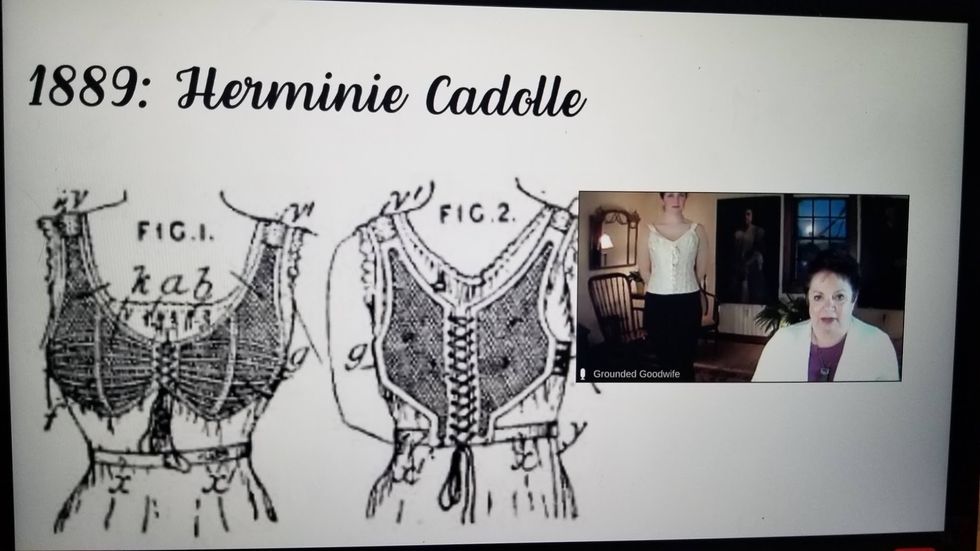MILLERTON — Taking a peek into a rather revealing history, the NorthEast-Millerton Library helped expose the history of the bra by inviting community members to attend the “Booby-Trapped” lecture hosted by Grounded Goodwife mother-daughter duo, respectively, Velya Jancz-Urban and Ehris Urban on Wednesday, March 24.
Starting at 7 p.m., both the library and the keynote speakers welcomed attendees to the Zoom lecture with gusto. Starting with the ancient Egyptians, the duo was eager to unfasten the history of the bra, with Urban frequently modeling different garments over her clothing as a visual demonstration.
Calling 1700s “a confusing time for breasts,” Jancz-Urban said breasts initially sat high up on the chest and were pressed against the rib cage in tight-fitting corsets; by the 1700s, she said they swelled out of the tops of dresses in two exaggerated orbs.
With the Regency Era (1811 to 1820), the divorce corset became popular. Contrary to its name, Jancz-Urban said the corset had nothing to do with marital problems, but was instead used to separate the breasts rather than flattening them against the front of the corset’s busk.
With the Victorian Era (1837 to 1901), those who opposed corsets argued in favor of suspending the weight of a woman’s breasts, undergarments and clothing from her shoulders. Yet the skirt alone could weigh up to 32 pounds, so coupled with the size of her breasts, Jancz-Urban said it was too much weight on a woman’s shoulders.
In 1876, Boston dressmaker Olivia Swift created a corset alternative, the Swift Waist, to allow beauty of form to be preserved without lacing or otherwise injuriously pressing or binding the body.
In 1889, French inventor Herminie Cadolle advertised a two-piece undergarment that split the corset into two pieces, with the lower part supporting the waist and the upper part supporting the breasts with shoulder straps.
Having fashioned the first brassiere out of two pocket handkerchiefs and ribbons, Mary Phelps Jacob would later patent the first bra in 1914 and found the Fashion Form Brassiere Company. However, after making a few hundred bras and selling them to department stores, Jacob was convinced by her husband to close the company. The patent was sold to Warner Brothers Corset Company for $1,500; the company would later make more than $15 million from Jacob’s design during the next 30 years.
Moving into the Jazz Years, Janez-Urban said, “If you remember nothing else from this time, remember that the look is flat,” before her daughter introduced the bandeau bra that would flatten the breasts to give women a more boyish shape.
Feminine curves would come back into style by the 1930s, and women’s fashion would focus on looking as though they weren’t wearing undergarments at all. Before cup sizes emerged in 1932, women determined their bra sizes as they correlated to lemons, oranges, grapefruits and melons. The word brassiere was shortened to “bra” and eye hooks and straps were added to the design.
“You’d never know there was a Great Depression going on with how bras were shaping up the era,” Jancz-Urban marveled.
The 1940s introduced the Torpedo or bullet-style bra, while the 1950s advertised the long-line bra and the ultra-feminine hourglass figure.
The first half of the 1960s introduced pattern bras and the Wonder bra, while the second half found flower children wearing a sheer, unsupportive no-bra or going braless. On Sept. 7, 1968, millions of viewers who tuned in to watch the Miss America Pageant pageant witnessed 400 women protesting the beauty concept outside. Bras, girdles, high heels, dish detergent, curlers and Playboy magazines were deemed instruments of torture and thrown into garbage cans. Because they couldn’t get a fire permit, Jancz-Urban said they didn’t do any burning, but the nickname “bra burners” would stick.
Not wearing a bra came into style in the 1970s, playing into the natural moment. This era would also applaud the creation of the sports bra (originally made from two jock straps sewn together) and the dawn of Victoria’s Secret.
Considered “the decade of more,” the 1980s showcased bras made out of materials like velvet, satin, Lycra and Jersey, while the Wonder bra skyrocketed into popularity in the 1990s as cleavage became fashionable again.
Women turned toward padded and T-shirt bras in the 2000s and to bralettes in the 2010s. With the new focus on the athletic body, health and wellness, sales of cleavage-boosting bras fell by 45% in 2017 while sales of wireless bras increased by 40%.
By 2021, the bra was declared a $10.2 billion a year industry.
“The only thing that is most important to know is there is no single adventure of the bra,” Jancz-Urban said. “From boyish flatness to Torpedo to plunge to sporty, where fashion goes, bras follow.”
















